Contents
Description
Almond is a branched shrub (tree) up to 6 meters high. Fruits are light brown and velvety in the form of seeds up to 3.5 centimeters in length and weighing up to 5 grams. Covered with small dimples and grooves.
Almonds contain more fiber, calcium, vitamin E, riboflavin, and niacin than any other tree nut. In addition, almonds are a low glycemic food. Like other nuts, almonds are high in fat. Fortunately, about 2/3 of these fats are monounsaturated, which means they are good for the cardiovascular system.
Almonds are a famous nuts. Despite the scientific definition of it to stone fruits of the Plum genus, in terms of taste and specificity of use, we consider almonds to be a nut, and we are happy to accept the epithets of scientists addressed to it: royal nut, king nut.
Almond history
The modern regions of Turkey are considered the birthplace of almonds. Here, the almond culture appeared many centuries before our era. In ancient times, almond blossom was a symbol of the beginning of the new year. For example, Israeli “tax workers” with the first almond blossom took their job – tithes from fruit trees. Almonds were also used to embalm the dead. So traces of nut oil were found in the tomb of the Egyptian king Tutankhamun.
If we talk about post-Soviet countries, then the earliest of all began to grow almonds in Tajikistan. It even has a separate “almond blossom city” called Kanibadam.
Now more than half of the world’s almond crop is grown in the USA, in the state of California. Almond trees are popular in Spain, Italy, Portugal.
Composition and calorie content

Nutritional value of almond
- Proteins – 18.6 g. Essential and non-essential fatty acids are valuable for the body. Their content in almonds is 12 and 8, respectively. Essential amino acids must necessarily come from the outside, because the body is not produced on its own.
- Fats – 57.7 g. Due to fats, 30-35% of the caloric content of the human diet is provided. They are found in all cells of the body. Moreover, they are “reserve” cells that accumulate chemical energy. With a lack of food, this energy will be used by the body. A sufficiently large amount of unsaturated fatty acids – 65%, contained in nuts, allows almonds to reduce cholesterol and remove it from the body, preventing the development of atherosclerosis. The body’s need for such fatty acids is 20-25 g per day and is 5% of the total calorie intake of a person’s diet.
- Carbohydrates – 13.6 g. One of the most important components of food provides the body’s energy needs quickly and efficiently. The starch (polysaccharide) contained in the plant helps to promote food, reduces appetite, and creates a feeling of fullness.
The chemical composition of the almond kernel
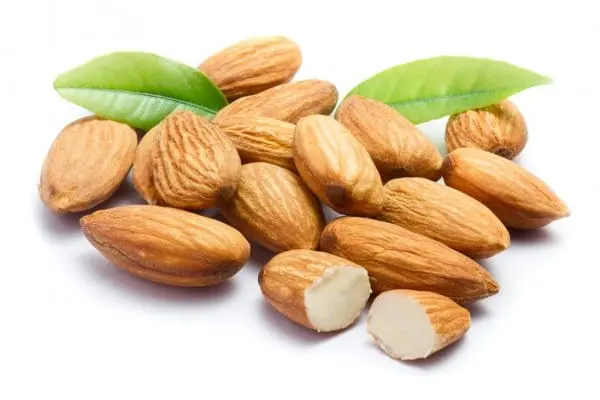
- Mineral substances (macronutrients). Their sufficiently high concentration in almonds ensures certain enzymatic reactions and the functioning of bioelectric systems. The required supply of minerals will be provided by eating just a few kernels per day. For example, 100 g of almonds contain 65% of the daily value of phosphorus, 67% magnesium, 26% calcium, 15% potassium.
- Trace elements: manganese – 99%, copper – 110%, iron – 46.5%, zinc – 28%. Human health is behind these numbers. Iron is involved in the processes of hematopoiesis, it is extremely necessary for hemoglobin. The daily human need for iron is 15-20 mg. 100 grams of almonds cover half the daily requirement. Copper is involved in neurological processes, stimulates the production of hormones, and is involved in tissue respiration. Manganese affects protein metabolism, is a part of enzyme systems.
- Vitamins: B2 (riboflavin) covers 78% of the daily human needs; B1 (thiamine) ensures the normal functioning of the nervous system; B6 (pyridoxine) – participates in the transport of iron by the blood, in the intestines and kidneys. Lack of vitamin will lead to disruption of the central nervous system, dermatitis will appear; B3 (pantothenic acid) – the body needs for normal growth, skin nutrition; vitamin C (ascorbic acid) provides mental and physical activity of the body; vitamin E (tocopherol) provides a lot in the body: the maturation of germ cells, is actively involved in spermatogenesis, maintains pregnancy, acts as a vasodilator. 100 grams of almonds contain 173% of the daily value for humans.
- Such a rich content of nutritional and medicinal components makes almonds unique and beneficial to health.
Calories per 100 g 576 kcal
The benefits of almonds
Almonds are beneficial due to their natural composition. It is considered an excellent source of calcium, iron, magnesium, phosphorus, and potassium. It contains a lot of B vitamins (B1, B2, B3, B5, B6, B9), as well as tocopherol (vitamin E). Almonds are good for the heart and blood vessels as they contain a lot of unsaturated fats, amino acids and minerals. Nuts are rich in plant flavonoids, which are activated by vitamin E.
To maintain the nervous system and normal functioning of the brain, doctors recommend consuming 20-25 nuts a day. For people aged 50+, almonds can help cope with dementia and Alzheimer’s disease. The plant antioxidants found in nuts normalize sleep and relieve senile insomnia and seasonal depression.
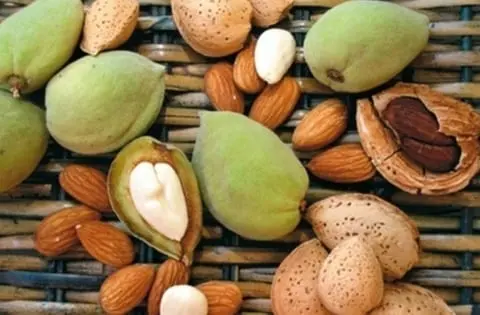
Fatty acids protect the body from excessive glucose entering the bloodstream. Therefore, almonds are good for people with diabetes. It also has a beneficial effect on microcirculation and immunity.
Dietary fiber helps to “cleanse” the body, it nourishes the intestinal microflora with beneficial bacteria, and affects prebiotic function. It is important to combine almonds with foods that contain many antioxidants – vitamin C, A, zinc and selenium. This includes cabbage, bell peppers, broccoli, citrus fruits, turkey, veal, chicken.
Almond harm
Almonds are an allergenic product. Therefore, people who have a tendency to allergic reactions need to be careful with this nut. Monitor its dosage. Allergies cause abdominal pain, diarrhea, vomiting, dizziness, and nasal congestion.
Also, do not overeat almonds, because nuts are high in calories and can cause an excess of fat. As a result, extra pounds may appear. Moreover, the restriction applies not only to overweight people. Overeating can cause flatulence, diarrhea and even headaches.
Do not overuse nuts for cores that have a non-standard heart rate. It is also better not to eat unripe almonds, as you can get poisoned because of the high cyanide content.
The use of almonds in medicine
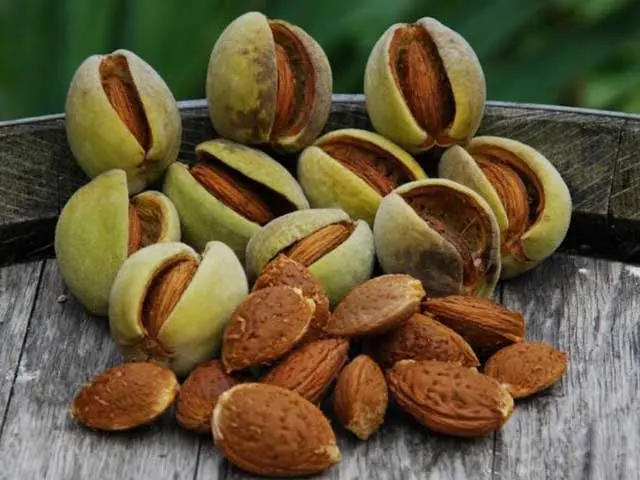
Almonds are often recommended to be consumed for various different diseases of the body. Since the nut is useful for blood vessels and the heart, it is recommended for the prevention of cardiovascular diseases.
Almonds are rich in various beneficial trace elements. In particular, calcium, magnesium, potassium and phosphorus. It contains a lot of monounsaturated fats and choline, which help the liver and central nervous system stay functional for as long as possible.
Almonds can be used as a cough suppressant. Due to the large amount of antioxidants, it can serve as an excellent anti-age agent and prevents early aging. Zinc strengthens the immune system and reproductive function (sperm health in men). A handful of almonds after a meal will discourage cravings for the usual dessert.
Almond oil can only be used for cosmetic purposes: it improves the condition of the skin and hair.
The use of almonds in cooking
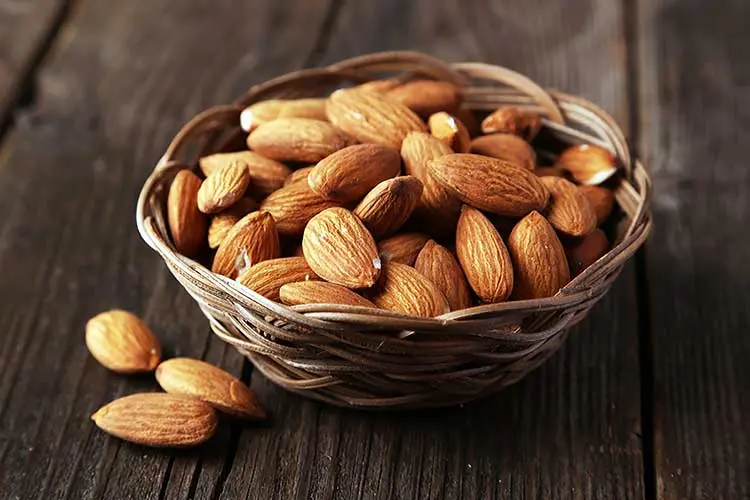
Almonds are used in different forms: fresh, toasted, salted. Nuts are added as spices in the manufacture of sweets from dough, chocolate, liqueur. Almonds give dishes a delicate and sophisticated taste.
Fortified milk is made from almonds. Moreover, it can be drunk even by those who are lactose intolerant. It is often consumed by vegetarians and vegans. For example, in Spain, a drink based on almond milk is called horchata, in France, horchada is prepared.
Many sweets are made from almonds. Marzipan – sugar syrup is mixed with almonds, praline – ground nuts are fried in sugar, nougat and macarons are also prepared. Whole nuts are sprinkled with coconut and chocolate. Recently, almond butter has been used as an alternative to peanut butter.
In Chinese and Indonesian cuisine, almonds are added to many meat dishes, salads and soups.
Almond allergy
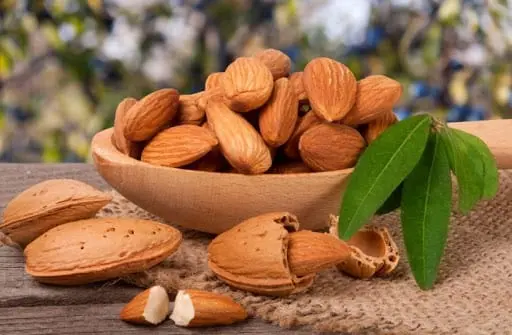
All nuts are classified as dangerous allergens. Most often, a high protein content provokes allergies. The rich composition of almonds, which, in addition to protein, contains many vitamins, macro and microelements, can cause an allergic reaction that occurs immediately after eating.
The main reason is weakened immunity. Scientists have found that in such cases, the immune system, which protects the body, perceives the protein as a dangerous substance, releases a chemical substance – histamine into the bloodstream and affects the tissues of a weak body (eyes, skin, respiratory tract, gastrointestinal tract, lungs, etc.)
In such cases, of course, you should consult an allergist. But folk remedies can also help: chamomile decoction, used externally and internally. Collection of herbs (oregano, string, calamus, St. John’s wort, licorice roots), brewed in a water bath, will also help. Take 50 ml three times after meals.
How does an almond tree grow?
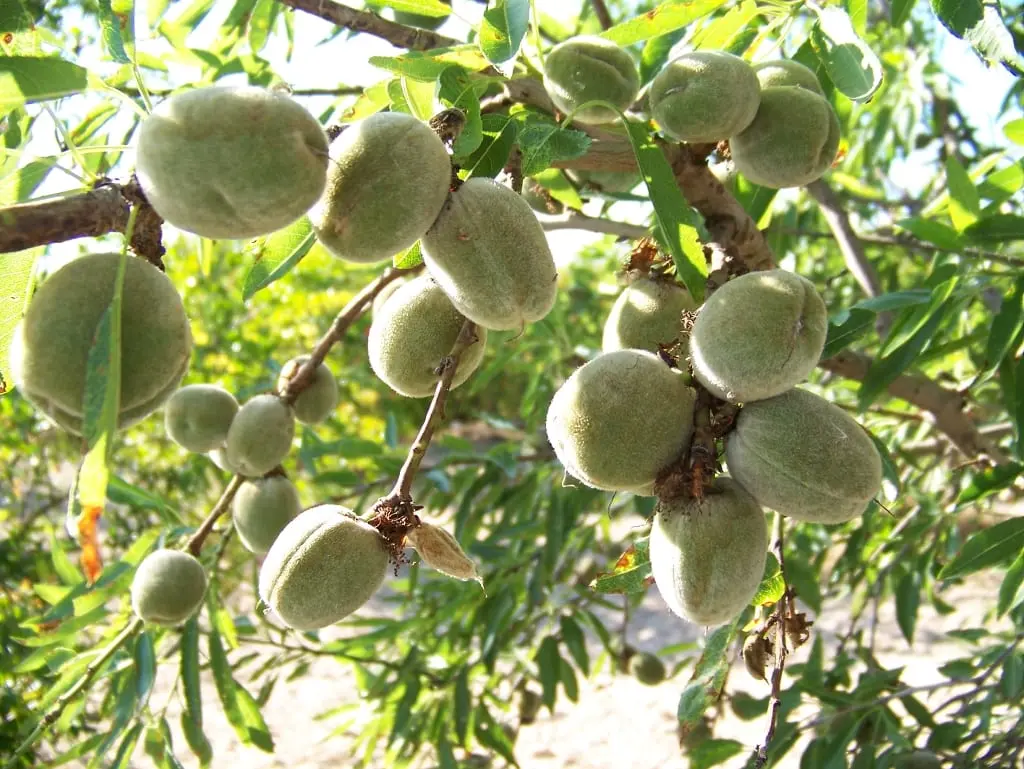
Blooming almonds are visible from afar. Even before the leaves appear, the most beautiful trees in the world are covered with white-pink gentle foam and attract thousands of tourists to different parts of the world to admire an extraordinary spectacle: numerous pink buds turn into large flowers of white and pink color.
Almond Blossom Festival
The Almond Blossom Festival is celebrated on 16 February. This day is recognized as World Almond Day and is celebrated in countries where amazing trees grow: Israel, Spain, Italy, China, Morocco, Portugal, USA (California). Each country has determined its place for almonds:
- in Israel it is a symbol of immortality
- in China – a symbol of prosperity and wealth
- in Morocco, they believe that the fruits of the almond tree bring happiness. A blooming almond seen in a dream portends the fulfillment of the most cherished desire.
- in the Canary Islands, this is a great excuse to taste the local almond wine and a variety of sweets. The blooming almond festival can last a month, while the tree is blooming, and turns into a folklore festival with a rich concert program, colorful processions in national costumes
Legends of Almond
Theatrical performances reproduce the Greek legend, according to which Princess Phyllida, young and beautiful, was in love with Theseus’ son, Akamant, who defeated the Minotaur. The war with the Trojans separated the lovers for 10 years. The beautiful princess could not stand the long separation and died of grief.
The goddess Athena, seeing such strong love, turned the girl into an almond tree. Having returned from the war, Akamant, having learned about the reincarnation of his beloved, hugged the tree, which immediately flashed with delicate flowers, so similar to Phyllida’s blush.
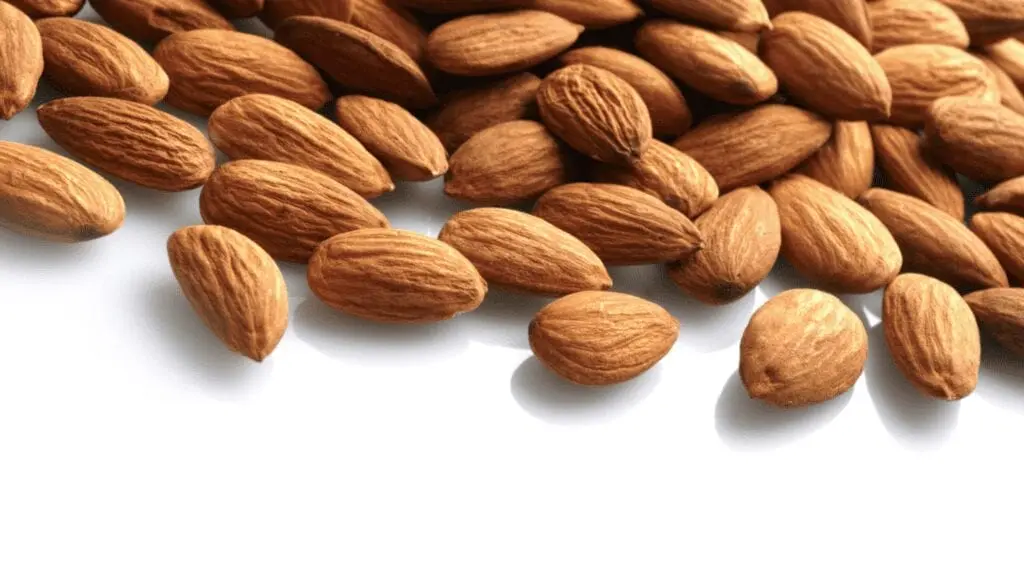
The Arab countries know their history of almonds: in ancient times, the ruler of the Algarve, Prince Ibn Almundin, fell in love with the beautiful northerner Gilda, captured. Having married a captive, the Arab prince was soon shocked by the illness of his young wife, caused by an unprecedented longing for his northern homeland.
No medicine helped, and then the ruler planted almond trees throughout the country. Blooming trees covered the entire kingdom with blooming snow, which reminded young Gilda of her homeland and cured her of her illness.
The fruits of the almond tree, which have an elongated shape, the edges of which end in a kind of arrow, served as a symbol of female beauty: the almond-shaped eyes, named so by Omar Khayyam due to a long nut, are still considered ideal, i.e. the standard of beauty.
People associated the bitter aroma with feelings (almond taste of love) and forensics (in many detectives, when investigating various crimes, the smell of bitter almonds is often present).









